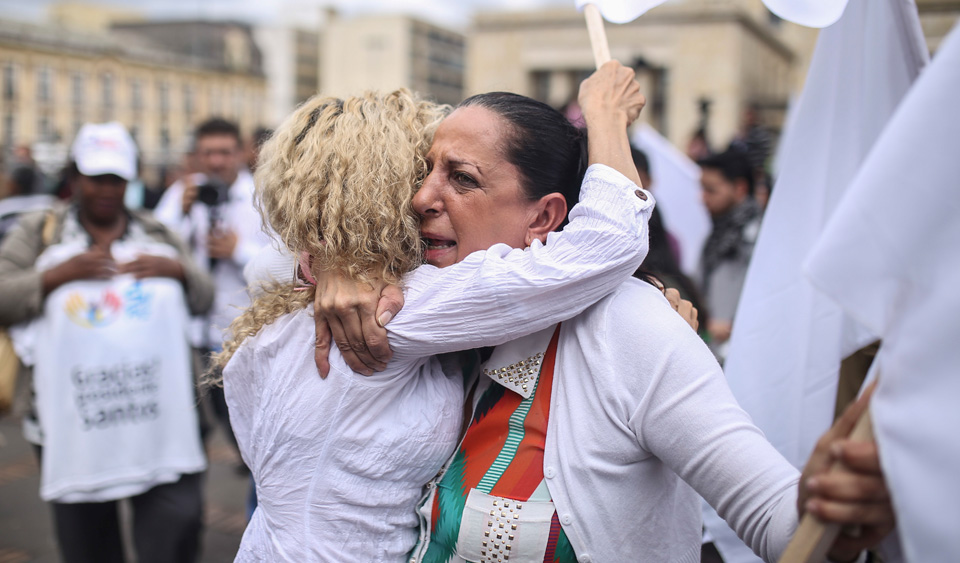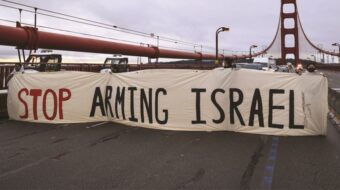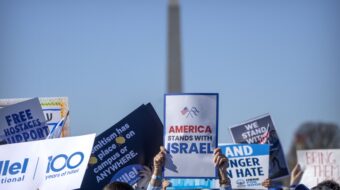
War between the Marxist-oriented Revolutionary Armed Forces of Colombia (FARC) and the Colombian government ended on Dec. 1. Colombia’s Congress that day finished endorsing the peace agreement President Juan Manuel Santos and FARC’s top leader, “Timochenko,” signed on Nov. 23. Voting in both chambers was unanimous, but only because Congressional opponents led by Senator Álvaro Uribe, Santos’ predecessor as president, walked out.
The war, which has lasted 52 years, has killed vast numbers of Colombians, 80 percent of them civilians, including rural community leaders and human rights activists.
The negotiations, including preliminary talks, consumed five years. Uribe, representing Colombia’s landowning class, led a campaign opposing the process. A final accord, signed and celebrated on August 29, went to a popular vote, a plebiscite, on Oct. 2. Voters responding to Uribe’s well-funded campaign narrowly rejected it.
What’s in the agreement?
Opponents claimed the agreement did little for victims, favored communists and LGBTQ people, and gave impunity to guerrillas. A Colombian economy in distress, they said, can ill afford money for implementing the peace deal.
The Santos government scrambled to recover. Negotiators reconvened to consider dozens of counter-proposals from the No side and did fashion a revised pact signed by the heads of both negotiating teams on Nov. 12.
The revisions represented fine-tuning rather than fundamental change. The Special Jurisdiction for Peace (JEP), set up to identify and sanction combatants who committed crimes, remained, but it won’t be part of the Constitution and will last for only ten years. Participating foreign judges serve only as advisers now. Colombia’s Constitutional Court will review JEP rulings. State agents who as combatants committed crimes will appear before the JEP, but not those who did so primarily for money.
Ex-guerrillas will submit “all information” related to narco-trafficking. FARC resources will be collected for use in paying for reparations. Some guerrillas involved with narco-trafficking through “rebellion or political crimes” may expect amnesty.
The revised agreement still allows former guerrilla leaders to participate in electoral politics, although state monetary support is diminished. Protection for the “so-called ideology of gender” disappeared, although rights are supposedly guaranteed for all population groups including LGBTQ people. Land reform provisions are weaker now; the new agreement affirms the right to private property and has a committee of experts reviewing land-reform projects.
Opposition forces called for former insurgents to be prosecuted by existing state institutions rather than by the JEP. The JEP did become a “state institution,” but on “an ad hoc” basis. Provisions for punishing ex-FARC leaders ineligible for amnesty were supposedly vague; the new agreement has them confined to small “agricultural colonies.”
One observer highlights language saying “Participation by the communities” – specifically politically active former guerrillas – is subject to “national authorities,” and “Implementation…of the accords will be consistent with prevailing budgetary norms, guaranteeing financial sustainability.”
No peace yet
Three sets of peace negotiations over 30 years failed. Now with an agreement in force, war will end – but not completely: the government’s talks with the guerrillas of the National Liberation Army are stalemated, and a dissenting contingent of the FARC’s Northern Front, having rejected the negotiations, is still fighting.
Most tellingly, violence has engulfed the country once more. The “Patriotic March” is a coalition of 600 social and political organizations. Its report of Nov. 22 says that during 2016, “72 defenders of human rights” have been murdered, 32 between August and November; 279 were threatened, and 30 escaped attackers. “Between Sept. 8, 2011 and Nov. 20, 2016, 124 comrades of the Patriotic March have been assasinated” – 18 in 2016.
The report emphasizes that, “[P]aramilitary action … looms as the principal threat to the peace process.” Basically, “genocide [is] being implemented through systematic actions directed at the extermination of our movement for political reasons.”
Aida Avella agrees: “There is a big plan against Patriotic March – that is to say, there are intellectual authors and there are financiers. But, “I don’t think another genocide is starting, rather it is a continuation…of genocide. That’s because the paramilitary structures have not been dismantled.”
Avella presides over the recently reconstituted Patriotic Union (UP) Party and knows about genocide. Peace talks ending in 1984 failed, but the government did allow demobilized FARC guerrillas to enter regular politics. They did so by helping to form the UP electoral coalition. Then murders began. Some 5,000 UP members would die. Avella herself went into exile in 1996 after a bazooka struck the taxi she was riding in.
The paramilitaries operate mainly in the countryside. Colombian Senator Ivan Cepeda claims, “The new campaign against restoring land [to the displaced] is part of a general strategy of paramilitaries protecting economic interests.” Ex-President Uribe, accused of links to paramilitaries, rejected the first agreement, because it will “collectivize the countryside and destroy productive agriculture.”
Fensuagro, Colombia’s largest agricultural workers union and a Patriotic March affiliate, is vulnerable. Death squads attacked nine Patriotic March members between Nov. 17 and 20; five were killed and three escaped (see note below). All but one belonged to Fensuagro.
Reporting the attacks, the Tucson-based Alliance for Global Justice highlights U.S. complicity. U.S. military advisors to Colombia’s government in 1962 held up paramilitaries as a sure cure for disorder in the countryside. U.S. military aid under Plan Colombia (2002-16) benefited paramilitary formations, directly and indirectly.
Currently, FARC members are deploying to “zones of concentration” where they will be handing over arms to United Nations officers. But conservatives tied to Uribe are preparing to retake the presidency in 2018. Some army officers broke rules in supporting Uribe’s crusade against the FARC, and may do so again.
Big agricultural interests, promoters of dams and mining, ranchers, and producers and distributors of drugs want to maintain their hold on useful land. And 9,000 political prisoners are still languishing in Colombian jails. Peace, for a while, will be a stranger in Colombia.
Jorge Eliécer Gaitán’s words bear repeating. Two months before he was assassinated on April 9, 1948, the Liberal Party leader spoke before a vast crowd. He did so because of murderous attacks on land-hungry small farmers.
He implored President Mariano Ospina Pérez: “Sir, stop the violence. We want the defense of human life, that’s what a people can ask for. Instead of unleashing blind force, we should take advantage of the people’s capacity to work for the benefit of the progress of Colombia… [T]his silent crowd and this mute cry from our hearts just demands this of you: that you treat us, our mothers, our wives, our children, and our property as you wish yourself, your mother, your wife, your children, and your property to be treated!”
(Note to readers: The Alliance for Global Justice on Dec. 1 issued an “Open Letter to Fensuagro, the Marcha Patriótica, and All the Colombian People.” The letter expresses condolences from 39 groups and 192 individuals and lists the names of victims. To add your name or that of your group, send an email to: afgj@afgj.org)












Comments